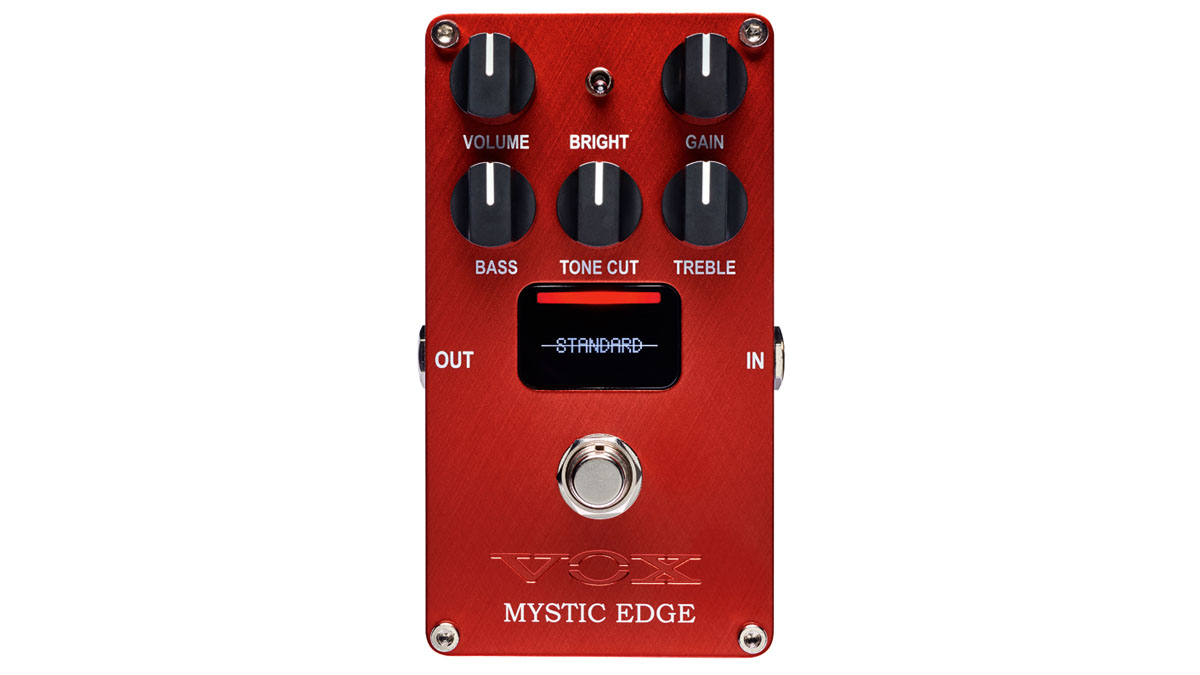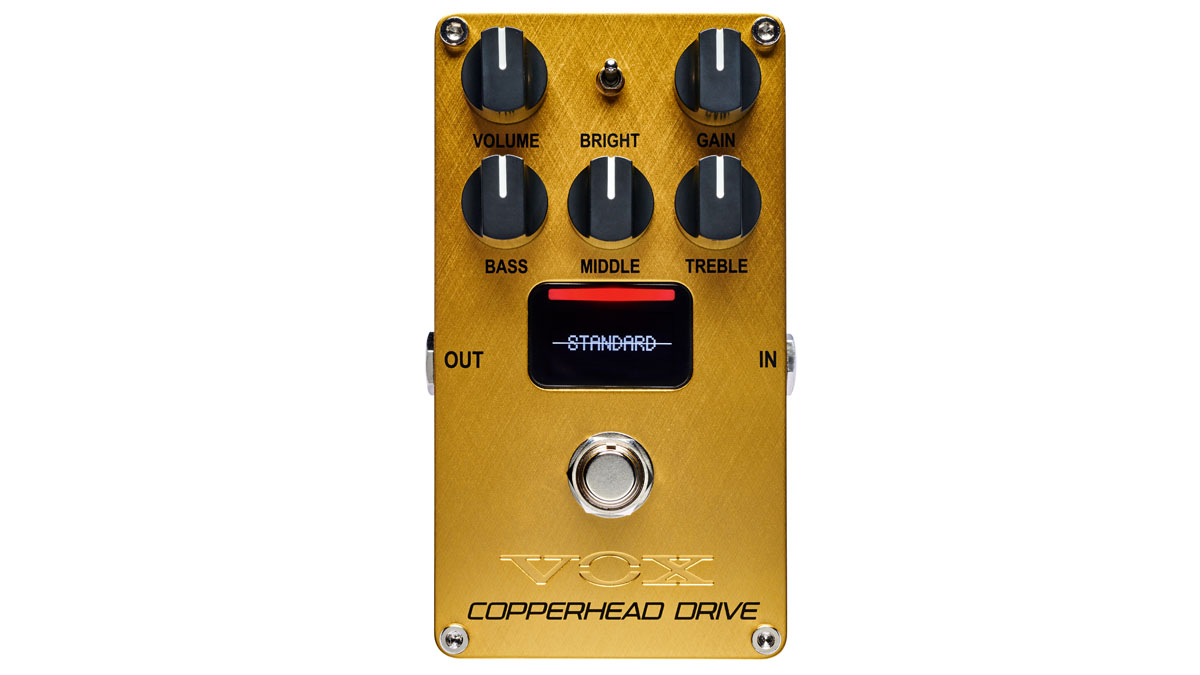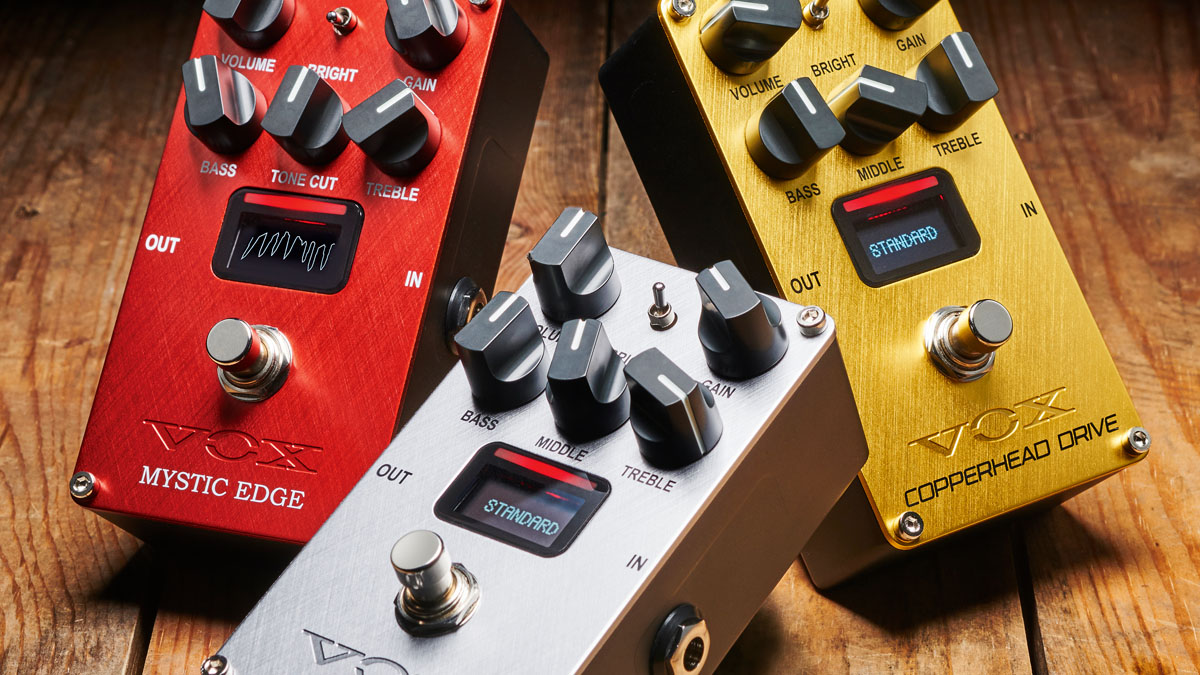Guitar World Verdict
With their musical drive and clever feature set, the Valvenergy series is a practical solution for adding another amp flavour in your signal chain, with the Silk Drive edging it for its versatility.
Pros
- +
The Mystic Edge nails the AC30 character.
- +
It can be used in preamp mode.
- +
Copperhead is a super-practical Marshall in a box pedal.
- +
The Silk Drive makes an excellent always-on sweetener.
- +
Onboard cab sims.
Cons
- -
Nothing, though the OLED is for decoration mostly.
You can trust Guitar World
The Valvenerergy pedals, each based around a Nutube miniature vacuum tube in its all-analogue signal path, are designed to emulate the response and harmonic distortion of a tube amp.
Four popular amp types are represented, in order of increasing gain: Silk Drive, Mystic Edge, Copperhead Drive and Cutting Edge.
Each pedal has an oscilloscope-like OLED display that shows the resulting waveform as you play and all have basically the same front-panel configuration, apart from the Cutting Edge (not featured here), which is based on a US high-gain amp suitable for metal tones and has a Tight knob in place of the Bright switch.
The pedals have a choice of three output modes: they can be used in standard pedal mode in front of your amp, as a line-level preamp or, with the built-in cab sim engaged, direct into an audio interface or PA. If you use two or more pedals together, a Channel Link feature lets you turn one pedal on while bypassing the others, rather like amp channel switching.
Vox Valvenergy Mystic Edge

The only one of the pedals that can be quite specific about its inspiration is the Mystic Edge, based on an AC30. It’s nicely responsive to playing dynamics and, with a combination of grit and chime, some familiar Vox tones are here to be explored.
The midrange character seems to be about right, so there’s no point messing with it, and where the other pedals have a Middle knob, here you get Tone Cut, as found in the original amp, adding an extra layer of tonal subtlety in calming down aspects of the top-end.
The gain range takes the pedal from clean to a fully cranked amp, offering plenty of punchy drive along the way, and while the analogue cabinet simulator offers a decent impression of the original’s 2x12 open-backed cab, there’s always the option to use the pedal in preamp mode and add an impulse response further down the line if you want different speaker simulation choices.
VERDICT: An AC30-in-a-box pedal from Vox itself. What’s not to like?
- PRICE: $179 / £169
- ORIGIN: Vietnam
- TYPE: Drive pedal
- FEATURES: Buffered bypass, oscilloscope display (switchable)
- CONTROLS: Volume, Gain, Bass, Middle, Treble, Bright switch, Mode switch (STD/PRE/CAB), Bypass footswitch
- CONNECTIONS: Standard input, standard output, Link
- POWER: 9V battery or 9V DC adaptor (not supplied) 95mA
- DIMENSIONS: 72 (w) x 120 (d) x 55mm (h)
Vox Valvenergy Silk Drive

The Silk Drive, based on an American clean amp, represents the amp with the lowest gain in this series. The drive in the pedal doesn’t really become apparent until past midway on the Gain knob, which allows it to be a useful clean boost and tone conditioning pedal.
There’s a certain scooped character in the midrange and (of course) a silky top-end, especially with the Bright switch engaged – a definite enhancement to your sound that you may wish to leave permanently on.
With further travel on the Gain knob things quite quickly get decidedly raunchy past three o’clock, but before you get there, there are some very attractive edge-of-break-up tones on tap.
Interestingly, the amount of clean headroom enables you to use the pedal into a distorted amp as a switchable clean channel. With cab sim engaged, this is a great choice for recording a range of clean tones, ably tweaked with the EQ knobs.
VERDICT: A versatile pedal with a range of uses, not least an alternative clean voice.
- PRICE: $179 / £169
- ORIGIN: Vietnam
- TYPE: Drive pedal
- FEATURES: Buffered bypass, oscilloscope display (switchable)
- CONTROLS: Volume, Gain, Bass, Middle, Treble, Bright switch, Mode switch (STD/PRE/CAB), Bypass footswitch
- CONNECTIONS: Standard input, standard output, Link
- POWER: 9V battery or 9V DC adaptor (not supplied) 95mA
- DIMENSIONS: 72 (w) x 120 (d) x 55mm (h)
Vox Valvenergy Copperhead Drive

It’s probably no coincidence that the Copperhead Drive, which Vox says is based around a British stack, has the same finish as a classic Marshall front panel. This is the pedal for vintage (and more modern) rock sounds and comes with fulsome low-end and midrange.
A full range of overdriven tones are covered here with plenty of dynamic crunch and grind leading the way to saturated lead tones, made all the better by engaging the Bright switch for some extra sizzle in the top-end to bring out the harmonics. For this whole series of pedals the oscilloscope-like OLED display window is cute, but it isn’t exactly necessary as long as your ears are still working.
However, the three output modes offer real versatility for live use and recording – the cab sim here will put some 4x12 heft straight into your DAW, while in standard mode this pedal will give your clean amp an M-flavoured makeover.
VERDICT: As MIAB pedals go, this one goes that extra mile in terms of practicality.
- PRICE: $179 / £169
- ORIGIN: Vietnam
- TYPE: Drive pedal
- FEATURES: Buffered bypass, oscilloscope display (switchable)
- CONTROLS: Volume, Gain, Bass, Middle, Treble, Bright switch, Mode switch (STD/PRE/CAB), Bypass footswitch
- CONNECTIONS: Standard input, standard output, Link
- POWER: 9V battery or 9V DC adaptor (not supplied) 95mA
- DIMENSIONS: 72 (w) x 120 (d) x 55mm (h)
- CONTACT: Vox
Trevor Curwen has played guitar for several decades – he's also mimed it on the UK's Top of the Pops. Much of his working life, though, has been spent behind the mixing desk, during which time he has built up a solid collection of the guitars, amps and pedals needed to cover just about any studio session. He writes pedal reviews for Guitarist and has contributed to Total Guitar, MusicRadar and Future Music among others.
“The original Jordan Boss Tone was probably used by four out of five garage bands in the late ’60s”: Unpacking the gnarly magic of the Jordan Boss Tone – an actual guitar plug-in that delivers Dan Auerbach-approved fuzz
“This is a powerhouse of a stompbox that manages to keep things simple while offering endless inspiration”: Strymon EC-1 Single Head dTape Echo pedal review












